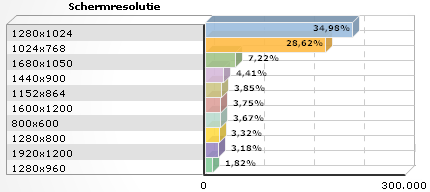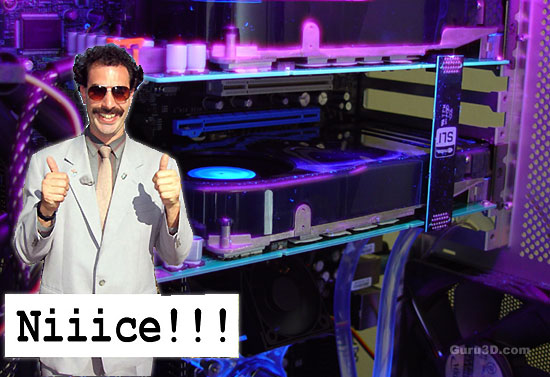Page 20
The Verdict
Interesting! Guys, this was a very complex to test and review product. See on one side we have the sheer power of 96 shader cores in the graphics processor to show off some really impressive stuff; yet on the other side as soon as you hit a high resolution you'll hit a wall as the amount of memory is holding you back. It's like buying an Aston Martin to drive around tight city streets. You can't use all it's power.
Then if we compare the tested 320 MB version towards a regular 640 Mb model of the GeForce 8800 GTS we see in the lower/normal resolutions that the 320 MB models are faster (compared to that 640 MB model) as they are allowed to be pre-overclocked; it does make this a very interesting product.
So let me sum it up in the easiest possible way for you:
Gaming up-to 1920x1200 = Good
Gaming after 1920x1200 = Bad
And then there is something flabbergasting: Windows Vista. With so much interest I'm following Vista driver development for the GeForce series; everybody knows this as I have been writing it ever since December in my reviews, NVIDIA is not delivering as promised. Overall performance is lacking (unless you use regular benchmark/games titles), and support is quite horrible (look at the dreaded 8800 support) and I'm not even touching the topic SLI here or the fact that there still is no WHQL driver available. So honestly, at the moment the combination of GeForce 8800 and Vista is just not something I full-heartedly recommend. Fact is, for this product review there wasn't even a driver ready on Vista. NVIDIA literally recommended the press to test with Windows XP.
Very interesting to see was that where the previous 8800 products had stickers and logo's on the box with "Vista Ready", with this card it's not the case. Not one little sticker. In fact right now I'm holding the XFX box in my hands, and on the side what is it saying?: "Designed for Microsoft Windows XP". So yes, NVIDIA has a thing or two to deal with when it comes to Vista support. Thing is, I have been working with NVIDIA for a long time now and every time a new graphics architecture rises, this is one of the weak spots that NVIDIA always has. The combo of a new architecture and a new operating system made it especially difficult somehow. I'll leave the topic as is with the knowledge that I also know that over the upcoming weeks we will see drivers that will bring a smile to our faces and deliver as promised. NVIDIA will definitely get that job nicely done, the question simply remains when ? It's just not something you want to hear when you just invested hundreds of dollars with the intention to take the Vista route.
When it comes to Vista I still recommend that XP is the way to go for now when it comes to gaming, that's a major advantage as it's where the series 8 products shine; and thus so does the 8800 320 Mb cards. Back to gaming. The fun thing about the GTS 320Mb cards is that they perform as well as the 450 EUR costing 640 Mb model; that's until you run out of memory (framebuffer) where everything travels to the dark side due to image quality settings and the lack of memory. It seems that up-to roughly a resolution of 1600x1200 and 1920x1200 mostly you can enable 4xAA and 16xAF without any huge impact compared to the 640 MB model. Go higher in resolution and you'll have to forfeit on IQ settings, it's that simple.
Now I did a quick poll on you guys and the following data is measured over half a million Guru3D visitors:
|
|
||
 |
||
Correct, the majority of gamers out there are still on an LCD screen at 1280x1024. Fact is though that roughly 15% of the resolutions are already at or above 1600x1200 and that number thus is rapidly growing. Go-go Guru3D enthusiast gamers ! :)
So that's the one huge recommendation I'd like to give you. If you aim at a higher resolutions then definitely go for the 640 model, or even better the delicious 768 MB GTX. There's another thing to keep in mind though, upcoming games that require massive amounts of texture memory can be an issue. A good example in our test run was GRAW; the GTS 640 MB model performed way better on all levels thanks to the fact it had enough memory. With upcoming DX10 titles like Crysis I'm confident that a larger framebuffer will really start to matter, a 512Mb graphics card would have been the way to go here.
Overclocking then, quite amazing. The tested cards today are overclocked by default and if you stick by the recommended resolutions you'll notice the card in most cases is faster than the standard clocked 640 Mb model. It's doesn't end there though; it seems we're allowed to overclock again as that tweaking range was just bloody amazing. Remember, 500 MHz is the reference default core clock frequency. I assure you, you can reach 600-650 MHz and if you are in bit of luck 700 MHz. If you want to go for such an excessive overclock then remember this, grab Rivatuner and force your fan-speed at a higher RPM, the results will be much better. And no, we did not do such a thing for today's OC, the RPM was set at reference. So that's just a hint I'd like to give you.
Right then, quite frankly I really like the GeForce 8800 GTS 320 MB series of graphics cards given the conditions I stated above. I adore the performance of the XFX card the best. At default it renders quite amazing numbers due to the higher clocks on core and memory. The BFG version stays slightly behind in overall performance compared to the XFX XXX version yet it's amazing performance wise as well. This is mainly due to the fact that XFX has it's memory clocked at 2x900 MHz, and as we'd tried to demonstrate today, memory matters big-time on this product. Furthermore, here in Europe you'll receive 2 years warranty on the XFX and you'll receive the full game Ghost Recon: Advanced Warfighter; that's pretty cool.
 BFG however is more conservative on the default (over)clock yet they do offer you a life-time warranty; which thanks to a tremendously stupid EU legislation has been reduced to 10 years here in Europe. So if you are in the stores that's that's a tough call to make. Do you go for slightly less performance and more warranty or do you go for first class performance, a free game yet only two years of warranty ? It's your call to make; obviously not an easy one. No-matter what model you'll choose, you'll absolutely adore the GTS 320Mb card as it offers really high-quality gaming and excellent performance and on the long term DX10 compatible gaming. Both cards will receive an editor's choice; BFG for the standard overclock and 10 years warranty and XFX for the best overclock and thus performance and the inclusion of a free game.
BFG however is more conservative on the default (over)clock yet they do offer you a life-time warranty; which thanks to a tremendously stupid EU legislation has been reduced to 10 years here in Europe. So if you are in the stores that's that's a tough call to make. Do you go for slightly less performance and more warranty or do you go for first class performance, a free game yet only two years of warranty ? It's your call to make; obviously not an easy one. No-matter what model you'll choose, you'll absolutely adore the GTS 320Mb card as it offers really high-quality gaming and excellent performance and on the long term DX10 compatible gaming. Both cards will receive an editor's choice; BFG for the standard overclock and 10 years warranty and XFX for the best overclock and thus performance and the inclusion of a free game.
The 320MB version of the 8800 GTS is like a feisty bull with one nut chopped off, it offers tremendous performance yet in the highest resolutions it can't deliver as it normally can do. I wish it would have had a 512MB framebuffer. But hey, in return you do get 96 shader cores in that graphics processor activated. Plain and simple; at this price level this product is very nice. For anyone with a monitor resolution up-to 16x12 or 19x12 this is a series of graphics card with tremendous possibilities and performance at a 300 USD/EUR price level. Nice !
The 320 MB models already have been spotted in our pricewatch database, click here to have a browse.
Hilbert|
|
||
 |
||
